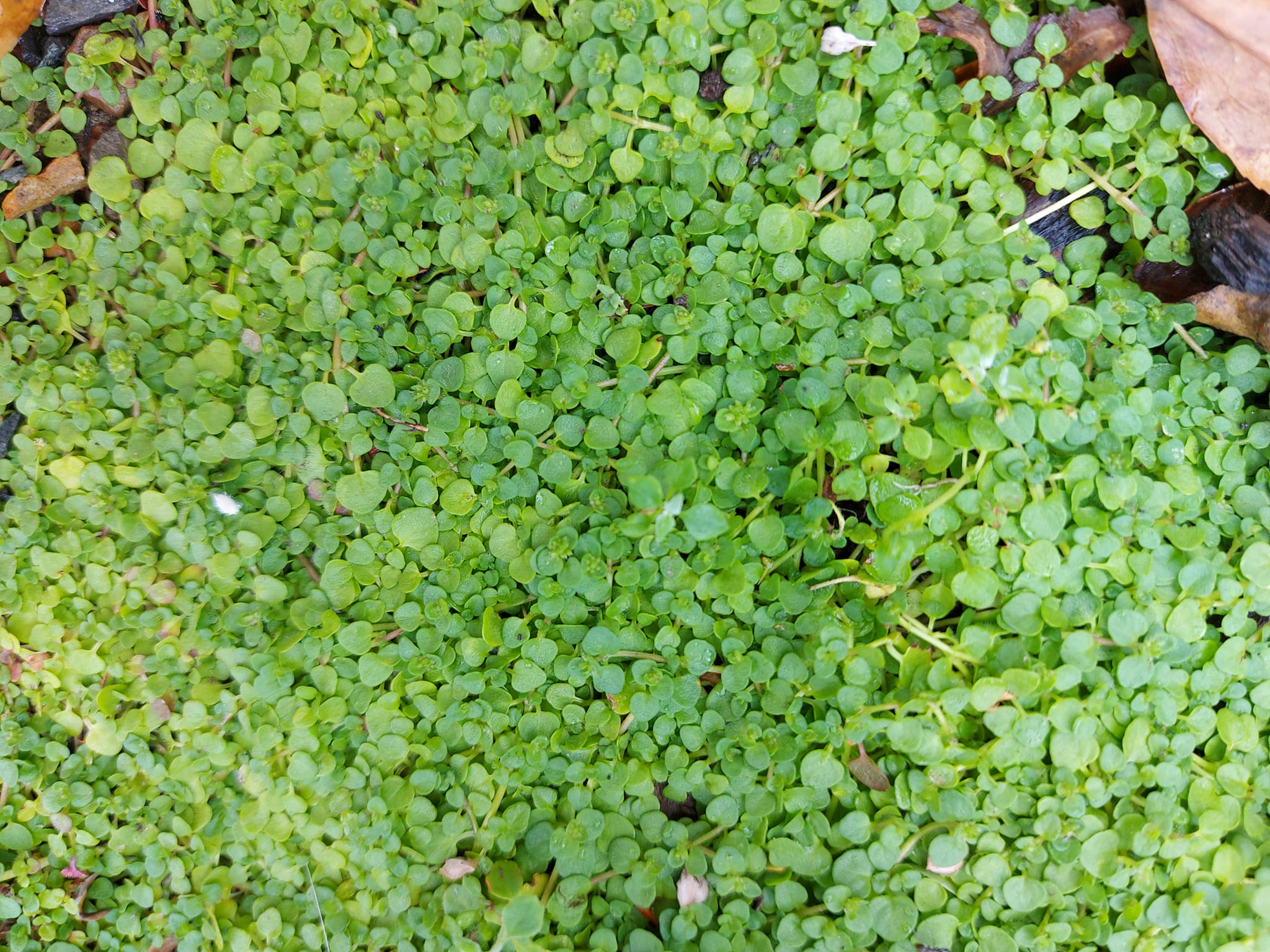Imagine being surrounded by a heady, vibrant, minty aroma whenever you walk on your lawn. This is what a Corsican mint lawn gets you. This Mediterranean- native plant is a popular alternative ground cover.
The highly versatile plant can be an excellent addition to your lawn or garden, provided you properly grow and care for it.
Besides growing this attractive plant in your yard, you can also plant Corsican mint (Mentha requienii) in containers together with flowers and other herbs.
Keep reading to learn everything about Corsican mint lawn if you want to introduce it to your property.
Can Corsican Mint Be Used As A Ground Cover?

Yes, you can use corsican mint as a ground cover for your lawn and enjoy its benefits. This mint family aromatic groundcover is native to Sardinia, Corsica, Montecristo, France, and other Italian regions but has been naturalized in more European regions, including the British Isles and Portugal.
Typically, most mint plants are large, upright, and leafy and grow invasively and aggressively.
Related Posts:
- Frog Fruit Ground Cover
- Best Edible Ground Cover Plants For Your Yard
- Dichondra Lawn Pros and Cons
- Chamomile Lawn
On the other hand, the Corsican mint, also called Mentha requienii, is slow-growing, pretty diminutive, and ground-hugging instead of growing upright.
It has extremely small, rounded, bright green leaves, half a pink nail’s size. When summer comes, your lawn will be covered by small blue-purple flowers.
This plant makes an excellent cover for walks and pathways. It grows well in USDA zones 6 to 9, with fairly warm summers and moderately cold winters.
In addition, while it can grow in a place with partial or full sun, it does better in shaded areas.
Corsican Mint Lawn Pros
Here are some advantages of using Corsican mint for your lawn:
1. It produces a potent mint flavor Fragrance
Corsican mint has a strong, pleasant aroma that is reminiscent of peppermint. Walking on the mint lawn releases the scent, creating a refreshing and invigorating experience.
2. No mowing hence low maintenance
Once established, Corsican mint requires minimal care. It is a low-growing plant that forms a dense mat, suppressing weed growth and reducing the need for mowing. It also has a good resistance to pests and diseases.
3. Drought-tolerant
Corsican mint is quite resilient and can tolerate dry conditions, making it suitable for areas with limited water availability. However, it does prefer consistent moisture, so occasional watering during dry spells can help maintain its lush appearance.
4. Visual appeal
The small, bright green leaves of Corsican mint create a lush carpet-like appearance, adding a vibrant and visually appealing element to your lawn. It works well as a border or between stepping stones, providing an attractive ground cover option.
5. Soil erosion control
The dense growth habit of Corsican mint helps stabilize soil and prevent erosion. It forms a thick mat of foliage that holds the soil in place, making it especially useful on slopes or areas prone to erosion.
6. Insect repellent
Mint plants, including Corsican mint, have a natural ability to repel certain insects. Planting it in your lawn can help deter pests like ants, flies, and mosquitoes, creating a more enjoyable outdoor space.
7. Culinary uses
Corsican mint leaves have a strong minty flavor and can be used in cooking or as a garnish for beverages and dishes. Having a mint lawn provides a readily available source of fresh mint leaves for culinary purposes.
Corsican Mint Lawn Cons
While Corsican mint can be a lovely addition to your lawn, there are also some considerations and potential drawbacks to keep in mind:
1. It can not tolerate heavy foot traffic
Corsican mint is delicate and sensitive to heavy foot traffic. Constant stepping or heavy use can cause the plants to become damaged or die off, leading to bare patches in your mint lawn. It is best suited for areas where foot traffic is minimal or can be restricted.
2. Slow establishment
Corsican mint has a slow growth rate, and it can take time for it to establish and fill in the desired area. Patience is needed during the initial phase as it may take several seasons for the mint to spread and create a dense carpet-like appearance.
3. It’s considered an invasive plant in Southeast
While Corsican mint is not considered invasive in the same way as some other mint varieties, it can still be quite vigorous and may spread beyond its intended boundaries if not managed properly. Regular monitoring and occasional trimming or containment measures may be necessary to prevent it from overtaking other plants or areas of your garden.
4. Specific growing conditions
Corsican mint has specific growing requirements and may not thrive in all climates or soil types. It prefers partial shade or filtered sunlight and moist, well-drained soil. It may struggle in hot, dry climates or overly wet conditions.
It’s important to assess your local growing conditions and ensure they are suitable for Corsican mint before planting it as a lawn alternative.
5. Limited mowing options
If you prefer the appearance of a manicured lawn and enjoy the act of mowing, Corsican mint may not be the best choice. It doesn’t tolerate regular mowing well due to its low-growing habit and delicate nature.
Trimming it with shears or using a lawnmower set at the highest height may be necessary to maintain its appearance.
6. Initial cost can be expensive
Corsican mint can be more expensive compared to traditional lawn grass seeds or sod. It is often sold in small pots or as plugs, which can be costlier when covering a larger area. Additionally, it may not be as readily available as other lawn options, requiring some effort to find a reputable supplier
Before deciding to use Corsican mint as a lawn alternative, it’s important to weigh these potential cons against the desired benefits. Consider the specific needs of your lawn and the level of maintenance and foot traffic it will experience to determine if Corsican mint is a suitable choice for your situation.
How To Plant Corsican Mint
You can grow Corsican mint from its seeds or propagation via division (more on this later). Experienced gardeners advise sowing the seeds indoors 4 to 6 weeks prior to the last date of frost.
You are better off starting the process in early spring since the seeds take a while to germinate and become seedlings.
If you choose to sow the seeds outdoors, ensure the temperatures are consistently a minimum of 65° F.
Lightly press Corsican mint seeds into the ground, then lightly spray water on the soil. The seeds will take 7-14 days to germinate.
Ensure the seedling tank has a big drainage hole, and to encourage fast germination, place the container in a properly lit area during morning hours.
Move the container away when temperatures increase to safeguard the seedlings from heat. Also, maintain moderately humid soil, so water your lawn accordingly.
Watering practices and climate can interfere with how Corsican grows. On the one hand, it needs moist soil, thus requiring regular watering when dry, but on the other, soggy soil can cause fungal problems in the roots, hindering the plant’s growth.
Moreover, cold weather can stop this groundcover’s growth, leaving it frozen. The solution to this is to use a thin mulch layer to protect it or wait until spring for it to self-seed.
Corsican mint grows in different soil types, including sandy, normal, and clay. This is why it will take over your yard if left unchecked, providing good ground cover even in areas with poor soils.
How Fast Does Corsican Mint Spread
Unlike other mint plants that grow aggressively, Corsican mint is a slow-growing plant that is somewhat difficult to grow.
It barely grows over ¼ inch tall and spreads to a distance of 6 to 12 inches wide. However, it can provide excellent ground cover under the proper growing conditions.
Propagating Corsican Mint
As mentioned, the other way to grow Corsican mint is through propagation, with the easiest method being via division. This involves dividing Corsican plants into tiny pieces and then planting them in different spots.
The plant will self-seed and keep spreading, filling the bare spots, thus offering proper ground cover.
Since it’s invasive, you do not cover your whole lawn when propagating; just let the small divisions grow and spread.
FAQs
Will Corsican Mint Take Over Grass?
Corsican mint will not take over your grass overnight because, unlike other mint plants, it’s not aggressive. In fact, it’s regarded as a well-behaved creeper.
However, ensure the Corsican mint plants in your yard have ample room to spread comfortably.
Will Corsican Mint Choke Out Weeds?
If you allow Corsican mint to grow, it will spread and cover weeds.
Is Corsican Mint Toxic To Dogs?
Generally, Corsican mint leaves are harmless but can be toxic when dogs consume them in large amounts.
Does Corsican Mint Keep Bugs Away?
Corsican mint produces a pennyroyal-like fragrance that repels bugs. This scent is produced when this plant is stepped on.
When it comes to mosquitoes, the plant itself will repel them, but the oils in it can, which you must extract to create a mosquito repellent. While the mosquitoes will not live in the plant, they will happily live close by.
Conclusion
To Sum up everything:
Corsican mint lawns pros are incredibly aromatic, releasing a refreshing scent when walked upon. They are low-growing and can withstand light foot traffic. They are attractive to bees and other pollinators and require little to no mowing.
Corsican mint lawns cons are have limited tolerance to heavy foot traffic and may suffer in hot, dry climates. They require well-drained soil and may struggle in overly wet conditions. Establishing them can be challenging, as they are slow-growing and may require regular maintenance to keep them contained.

Hey there, I’m Derek Schew, a writer for Lawnholic.com, where we cover everything and anything related to lawns. As someone who’s spent countless hours tending to my own lawn, I’m passionate about sharing my knowledge and helping others achieve the perfect yard. From lawn care tips to product reviews, I’m committed to providing our readers with the most accurate and up-to-date information available. So whether you’re a seasoned lawn enthusiast or just getting started, I invite you to join our community and discover the joys of a lush, green lawn.

